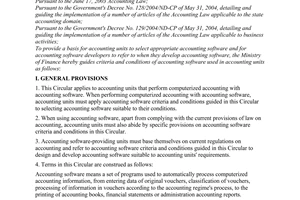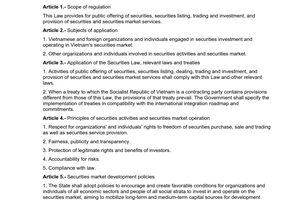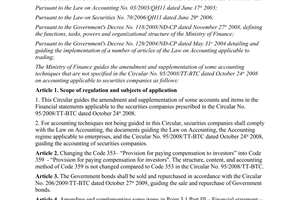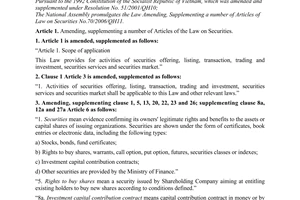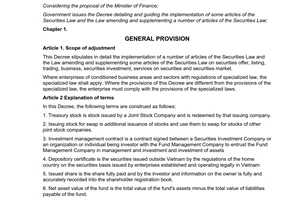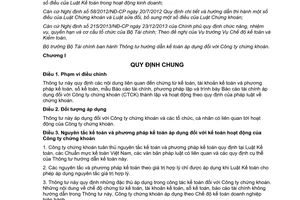Nội dung toàn văn Circular No. 210/2014/TT-BTC accounting policy applicable to securities companies
|
THE MINISTRY
OF FINANCE |
SOCIALIST
REPUBLIC OF VIETNAM |
|
No: 210/2014/TT-BTC |
Hanoi, December 30, 2014 |
CIRCULAR
PROVIDING GUIDANCE ON ACCOUNTING POLICY APPLICABLE TO SECURITIES COMPANIES
Pursuant to the Law on Accounting No. 03/2003/QH11 on June 17, 2003;
Pursuant to the Law on Securities No. 70/2006/QH11 dated June 29, 2006 and the Law No. 62/2010/QH12 dated November 24, 2010 amending and supplementing a number of articles of the Law on Securities No. 70/2006/QH11 dated June 29, 2006;
Pursuant to the Government’s Decree No. 128/2004/NĐ-CP dated May 31, 2004 providing instructions on the implementation of a number of articles of the Law on Accounting applicable to the state accounting domain and the Government's Decree No. 129/2004/NĐ-CP dated May 31, 2004 providing instructions on the implementation of a number of articles of the Law on Accounting in business;
Pursuant to the Government's Decree No. 58/2012/NĐ-CP dated July 20th 2010, detailing and guiding the implementation of a number of articles of the Law on Securities and the Law on amending and supplementing a number of articles of the Law on Securities;
Pursuant to the Government's Decree No. 215/2013/NĐ-CP dated December 23, 2013 defining the functions, tasks, entitlements and organizational structure of the Ministry of Finance;
At the request of the Director of the Department of Audit and Accounting Regulation
The Minister of Finance promulgates the Circular providing guidance on accounting policy applicable to securities companies.
Chapter I
GENERAL PROVISIONS
Article 1. Governing scope
This Circular prescribes contents relating to the accounting vouchers, accounting accounts and accounting methods, accounting books, forms of financial statements, methods of preparation and presentation of financial statements applicable to securities companies established and operating under the provisions of legislation on securities.
Article 2. Regulated entities
This Circular applies to securities companies, organizations, and individuals related to the operation of securities companies.
Article 3. Accounting principles and accounting methods applicable to accounting operation of securities companies
1. Securities companies comply with the accounting principles and the accounting methods prescribed in the Law on Accounting, Vietnamese Accounting Standards, relevant legal documents, and specific provisions of this Circular.
2. The principles and methods of accounting under the fair value are only applied when they are allowed by the Law on Accounting.
3. This Circular stipulates specific contents applicable to the accounting of securities companies. For contents of accounting vouchers, accounting accounts, accounting books, financial statements that are not included in the guidance of this Circular, securities companies comply with the current accounting policy for enterprises .
Chapter II
GUIDANCE ON ACCOUNTING POLICY APPLICABLE TO SECURITIES COMPANIES
Section 1. ACCOUNTING VOUCHERS
Article 4. General principles
1. Accounting vouchers are papers and information carriers recorded economic, financial transactions arisen and finished as the basis for book-entries.
2. Accounting vouchers applicable to securities companies must comply with the contents, methods of preparation, and signing vouchers under the provisions of the Law on Accounting, the Decree providing detailed guidance on the Law on Accounting applicable in enterprises, other legal documents relating to the accounting vouchers, and the provisions in this Policy.
Article 5. Preparation of accounting vouchers
1. Accounting vouchers are prepared for all economic, financial transactions arising and relating to the operation of securities companies. Accounting vouchers are only prepared once for an economic, financial operation. Contents of an accounting voucher must include all items, must be clear and honest with the contents of the arising economic, financial transaction. Handwriting in the vouchers must be clear without any erasion or abbreviation. The amount in words must match exactly the amount written in numbers.
2. Copies of an accounting voucher must be made sufficiently as prescribed. For vouchers having many copies, all such copies must be made once using computer or carbon paper. In special cases where many copies cannot be written once, they may be written twice as long as consistency of content and legality of all such copies are guaranteed.
3. Accounting vouchers which are prepared using computer must include the prescribed contents.
Article 6. Signing accounting vouchers
1. All vouchers shall only be valid if they are fully signed under the titles therein. Electronic vouchers must have electronic signatures as prescribed by the law. All accounting vouchers must be signed using a ballpoint pen or ink pen. Red ink and pencil are prohibited. All copies of accounting vouchers used for payment must be signed. The signature of a person in accounting vouchers must be consistent and must match his/ her registered signature as prescribed, if such person did not register for his/her signature, the signature of current time must match the signature of previous time.
2. The signature of the head of a securities company (General Director, Director or authorized person), of the chief accountant (or an authorized person), and the stamp in vouchers must conform to the specimen stamp and the valid signature which were registered at the commercial bank. The accountant's signature in the voucher must match the signature registered with the chief accountant.
3. The chief accountant (or authorized person) is not allowed to sign the word "authorized" of the head of the securities company. The authorized person is not allowed to authorize to others.
4. Every securities company must open a register of specimen signatures of accountants, chief accountant (and an authorized person), General Director, Director (and an authorized person) relating to its operation. Such register must be paginated and stamped on the edge of every page and managed by the head of the company (or an authorized person) in order to facilitate inspection. Each person must sign three specimen signatures in the register.
5. Individuals who are entitled or authorized to sign the vouchers are not allowed to sign them before the contents of such vouchers are recorded insufficiently under the responsibility of the signatories.
6. The decentralization of signing in the vouchers shall be prescribed by the general Director or the Director of securities companies in consistence with the law and the requirements for management in order to ensure strict control, asset security of the company.
Article 7. Order of circulation and inspection of accounting vouchers of securities companies
1. All accounting vouchers prepared by the securities company or transferred to from outside entities must be concentrated in the accounting department of the securities company. The accounting department inspects such accounting vouchers which shall be used for making entries in the accounting books only after being inspected and verified as true.
2. Circulation order of accounting vouchers includes the following steps:
- Preparing, receiving, and processing accounting vouchers
- Inspecting and signing vouchers or requesting the General Director or Director of securities companies for signing (carried out by accountants, chief accountant)
- Classifying, arranging vouchers, determining amounts and recording accounting books.
- Retaining accounting vouchers.
3. Inspection order of accounting vouchers
- Inspecting the clarity, truthfulness, and completeness of items recorded in the accounting vouchers.
- Inspecting the legitimacy of arising economic, financial transactions recorded in accounting vouchers, comparing accounting vouchers with relevant documents.
- Inspecting the accuracy of data and information in vouchers.
4. When inspecting accounting vouchers, if detecting any violations against the policies, regulations, provisions of the current law on establishment and management of securities companies, Regulations of securities companies, Resolution on Shareholder general assembly, member Assembly or Resolution on Board of Directors under the decentralization, accountant department must refuse to perform (refuse to make payment, ...) and immediately report to the General Director, Director of securities companies for timely handling in accordance with the current law.
For accounting vouchers that are prepared inconsistently with procedures, contents and of which numerical symbols are not clear, the person responsible for inspecting or recording books must return them and request for additional procedures and adjustments before recording books based on them.
Article 8. Translation of vouchers into Vietnamese
1. The accounting vouchers which are written in foreign languages, when being used to record the accounting books in Vietnam must be translated into Vietnamese. The entire contents of vouchers that rarely arise or repeatedly arise which have different contents must be translated. For vouchers that repeatedly arise and have the same content, only main contents such as: name of the vouchers, name of unit or individual preparing the vouchers, name and individual receiving the vouchers, economic content of the vouchers and titles of the persons signing the vouchers are translated ...
2. The translators must sign and write their full name and must be responsible for the content translated into Vietnamese. The Vietnamese translation must be accompanied with the original in foreign language.
Article 9. Use, management, printing, and issuing of accounting vouchers
1. All securities companies must use uniformly the accounting voucher forms prescribed in this accounting Policy and other relevant vouchers in conformity with the law of the relevant fields . During the implementation process, the securities companies are not allowed to rectify the mandatory vouchers.
2. Pre-printed voucher forms must be preserved carefully, must not be damaged or rotten. Checks and valuable papers must be managed under the regulation on management of currency.
3. For guiding accounting vouchers forms, securities companies may purchase or design and print by themselves as long as the main contents of the vouchers specified in this Circular and the provisions of the Law on Accounting are guaranteed.
Article 10. Use of electronic vouchers and retention of kinds of vouchers
1. Securities companies that use electronic vouchers for economic, financial operations and book- entries must comply with the regulations on electronic transactions and relevant law provisions of electronic vouchers.
2. Securities companies retain accounting vouchers in accordance with the provisions of law.
Article 11. List and forms of accounting vouchers
1. Accounting vouchers applicable mainly to securities companies comply with the list and the forms prescribed in Annex 01.
2. State Securities Commission shall provide specific guidance on the voucher system applicable to securities companies for conducting business transactions in securities.
Section 2. ACCOUNT SYSTEM APPLICABLE TO SECURITIES COMPANIES
Section 12. Provisions of account system applicable to securities companies
1. Accounts are used for classification and systematization of financial and economic transactions according to economic contents.
2. The system of accounts of securities companies includes accounts of level 1, level 2, level 3, and level 4 in the Balance sheet and accounts off-Balance sheet as prescribed in this Circular.
3. Securities companies base on the account System prescribed in this Guidance on accounting applicable to securities companies to apply and elaborate the account system in accordance with the characteristics of business, requirements for management of each type of operation of unit, and in accordance with the contents, structures, and accounting methods of the respective control accounts.
4. If securities companies wish to supplement accounts or adjust names, codes, contents and accounting methods of particular economic transactions of accounts level 1, level 2 and level 3, they must gain a written approval from the Ministry of Finance.
5. At the request of management, securities companies are allowed to open accounts from level 4 or higher without the approval from the Ministry of Finance.
6. The account system list applicable to securities companies which describes contents, structures, and accounting methods is included in Appendix 02.
Section 3. REGULATIONS ON ACCOUNTING BOOKS
Article 13. General provisions
1. Accounting books are used to record, systematize and retain all of economic and financial transactions that have arisen under the economic content and time order relating to securities companies.
2. Securities companies must comply with the provisions of accounting books in the Law on Accounting, the Government’s Decree providing guidance on the implementation of a number of articles of the Law on Accounting in business, the documents providing guidance on the Law on Accounting, and this Circular.
Article 14. Types of accounting books
1. Securities companies have only one accounting book system used for an accounting year. Accounting books include general accounting books and detailed accounting books.
- The general accounting books include: the Journal, the Ledger.
- The detailed accounting books include: detailed accounting books.
2. Securities companies are required to comply with book forms, contents and methods of making entries for Ledgers and Journals; provisions oriented guidance on detailed accounting books.
3. General accounting books
The Journal
a) The Journal is used for recording economic and financial transactions arising in each accounting period and in an accounting year according to the time order and reciprocal relations among accounts of such transactions. The accounting data in the Journal must be recorded the total amount arising in the Debit side and the total amount arising in the Credit side of all accounting accounts used at securities companies (general Journal) except for the accounts that are monitored and recorded in special Journals;
b) The Journal must be fully recorded the following factors:
- Day, month of book entry;
- Serial number and date of issuance of accounting vouchers used as basis for book entries;
- Summary of contents of the arising economic, financial transactions;
- Amount of the arising transactions;
Special Journals
Special Journals include purchase Journal, sales Journal, cash, cash –in-bank receipt Journal, cash, cash-in-bank payment Journal; Such special Journals are opened and used for recording the transactions separately prescribed for each type of the Journals, such as: purchase Journal is used for recording purchase transactions arising in the accounting period which are unpaid.
The Ledger
The Ledger is used for recording economic and financial transactions arising in each accounting period and an accounting year according to accounting accounts prescribed in the accounting account system applicable to securities companies. The accounting data in the Ledger must be recorded the situation on assets, capital sources, the situation and results of business operation of securities companies. The Ledger must be fully recorded the following factors:
- Day, month of book entry.
- Serial number and date of issuance of accounting vouchers used as basis for book entries.
- Summary of contents of the arising economic, financial transactions.
- Amount of the arising economic, financial transactions, inscribed in the Debit side or the Credit side of the account.
4. Detailed accounting books
The detailed accounting books are used for recording arising economic, financial transactions relating to accounting objects that need to be monitored in detail according to managerial requirements. The data in detailed accounting books supply information to serve the management of each kind of asset, capital source, revenue, and expenditure that have not been recorded in the Journal and the Ledger;
b) The quantity and structure of the detailed accounting books are not compulsorily prescribed. Securities companies shall have to base on the provisions of this Circular on detailed accounting books and their managerial requirements to open necessary and appropriate books of detailed accounting.
Article 15. Accounting book system
1. Each securities company has only one official and unique accounting book system for an accounting year.
2. Securities companies must base on accounting account system applied in the securities companies and their own management requirements to open enough necessary general accounting books and detailed accounting books.
Article 16. Responsibilities of book keepers and inscribers
1. The accounting books must be strictly managed, with the book-keeping and entering responsibility being assigned to individuals. Employees assigned the accounting books shall have to bear responsibility for things inscribed therein and to keep the books during the time of using them.
2. In case of change of the accounting book keepers and inscribers, the chief accountant shall have to organize the transfer of responsibility for management and entering accounting books between the out-going accountants and the in-coming accountants. The transfer note must be signed for certification by the chief accountant.
Article 17. Recording accounting books using hand or accounting software.
1. Securities companies are allowed to record accounting books using hand or accounting software.
2. In case of recording accounting books using hand, accounting units must comply with the accounting models, accounting book forms, and provisions of general Journal form. Accounting units are allowed to open more detailed accounting books according to their management requirement.
3. In case of recording accounting books using accounting software, securities companies are allowed to choose either purchase or design an accounting software accordingly. Forms of general Journal on the accounting software applied in securities companies must meet the following requirements
a) Have all necessary general accounting books and detailed accounting books to meet the accounting requirements as prescribed. The general accounting books must contain all the contents prescribed by the Regulations on accounting books;
b) Strictly comply with the regulations on opening, recording, closing and rectifying the accounting books as prescribed by the Law on Accounting, the documents guiding the implementation of the Law on Accounting, and the provisions in this Circular;
c) Securities companies must base on the standards and conditions of accounting software prescribed by the Ministry of Finance in Circular No. 103/2005 / TT-BTC dated November 24, 2005 and amending, supplementing documents (if any) to choose an accounting software suitable to their management requirements and conditions.
Article 18. Opening and recording accounting books
1. Opening accounting books
a) The accounting books must be opened at the beginning of the accounting year. For a newly-established securities company, the accounting book must be opened from the date of its establishment. The legal representative and chief accountant of an securities company shall have to sign for approval of the accounting books recorded by hand before they are used, or sign for approval of official accounting books after they are printed from accounting software;
b) The accounting books must be used pre-printed forms which may be bounded into volume or may be in loose sheets. These sheets should be bounded into a volume after use for retention;
c) Before the accounting books are used, the following procedures must be completed:
- For accounting books in volume :
The name of the securities company, the book title, the date of book opening, the accounting year and book- entry period, the full name and signature of the book keeper, inscriber, chief accountant and legal representative of the securities company, the date of finishing book entry or the date of transferring the book to another person must be clearly written on the first page of the book.
Pages must be paginated from the first to the last page and stamped with the seal of the accounting unit at places between two pages;
- For books in loose sheets:
The name of the securities company, the ordinal number of each book sheet, the book title, the month of use, the full name of the book keeper and inscriber must be clearly inscribed at the top of each loose sheet. The loose sheets, before being used, must be signed for certification, stamped, and recorded in the register for use of loose-sheeted books by the director (general director) or authorized person. The loose-sheeted books must be arranged in the account in order to ensure safety and easy access.
2. Recording accounting books
Recording books must necessarily be based on the accounting vouchers which were inspected and meet regulations on accounting vouchers. All data recorded in accounting books are required to have legal and reasonable accounting vouchers.
3. Closing accounting books
At the end of the accounting period, accounting books must be closed before the financial statement is prepared. In addition, accounting books must be closed in the inventory or other cases as prescribed by law.
Article 19. Correction of accounting books
1. When errors in the accounting books which are recorded using hand are detected during book-entry, it is prohibited to erase untraceably wrong information and data. Correction must be made using one of the following methods:
a) The method of correction (also called method of wiping out):
This method is used to correct errors in accounting books, the wrongly inscribed figures shall be crossed out with a straight line so that the wrongly inscribed content which has been crossed out can still be seen. Above the crossed-out place, the correct figure shall be inscribed in common ink. The corrected figures should be certified to their sides with the signature of the Chief accountant or accountant. This method is used in case:
- Errors are made in the explanation and not related to the reciprocal relationships between accounts;
- Errors do not affect the total money amounts.
b) The method of negative figure inscription (also called the method of red inscription):
This method is used to correct errors as follows : all the wrong entries must be re-written in red ink to cancel these entries, then later the correct entries shall be written in common ink in replacement thereof.
This method is used in case:
- Errors relate to the reciprocal relations between accounts due to wrong determination of amounts, which have already been inscribed in the accounting books and cannot be corrected by the method of correction;
- Errors are detected after financial statements have been submitted to competent agencies. In this case, the correction of errors in the accounting books in the year of detection of errors under the prospective or retroactive method is permitted under the provisions of Accounting Standard "Changes in accounting policies, accounting estimates and errors ";
- Errors are made when the amounts of money in accounts have been inscribed time and again or the wrongly inscribed figures are bigger than the correct figures.
When using the method of negative figure inscription to correct errors, a "corrected book entry voucher" must be made and signed for certification by the chief accountant (or an accountant).
c) The method of additional inscription
This method shall apply to cases where the entries are inscribed correctly for the reciprocal relations between accounts but the inscribed money amounts are smaller than the money amounts in the vouchers or the money amounts inscribed in vouchers are omitted and not fully added up. In case of correction by this method, the "corrected book entry voucher" must also be made to additionally record in normal ink the difference amount.
2. Correction of book entries using accounting software:
a) If errors are detected before annual financial statements are submitted to competent State agencies, the correction can be made directly in accounting books of such year on the accounting software;
b) If errors are detected after annual financial statements are submitted to competent State agencies, the correction can be made directly in accounting books of the year in which errors are detected on the accounting software and noted in the last line of the accounting books of year in which errors are made;
c) Cases of correction of book entries using accounting software are made according to the “method of negative figure inscription” or “method of additional inscription”.
3. When the annual settlement report is approved or when the inspection and auditing have been completed and an official conclusion is given, if there is a decision to correct the figures in the financial statements relating to figures that were recorded in accounting books, the unit must correct the accounting books and the Balance of the relevant accounts under the prescribed method. The correction is made directly in the accounting books of the year in which errors are detected , and taken notes on the last page (last line) of the accounting books of the year prior to the year of error (if errors are detected after the annual financial statements are submitted to the competent State agencies) for convenient comparison and inspection.
Article 20. Adjustment of accounting books
Where securities companies must apply a retroactive adjustment due to changes in accounting policy and must make a retroactive adjustment due to detecting material misstatements in the previous years under the provisions of Accounting Standard "Changes in accounting policies, accounting estimates and errors", accountants must adjust beginning balance in general accounting books and detailed accounting books of relevant accounts.
Article 21. Accounting book forms
1. Securities companies are allowed to apply the following accounting form:
- General journal.
- In this accounting form, there are specific provisions on the quantity, structure, form, order and method of recording and the relationship between the accounting books.
2. Securities companies must base on the size and characteristics of business operation, requirements for management, professional qualifications of accounting personnel, technical equipment conditions to calculate and choose a suitable accounting software, and must comply with the provisions of the accounting book form applicable to the operation of the securities companies including: Type and structure, comparison and inspection relation, order, recording method of accounting books.
3. If the general Journal form is applied using accounting software program, securities companies must comply with the principles, procedures for opening, recording, and closing accounting books under such accounting form in order to record arising transactions. Securities companies must formulate a process for book entries which complies with the provisions of the current accounting policy applicable to securities companies, regulations on decentralization of book entries, control and approval of the transactions that are recorded in accounting books, transferring and summarizing figures for preparation and presentation of financial statements, administrative accounting reports, and other reports in accordance with the provisions of the legislation on accounting, securities, other current relevant laws, and regulations of securities companies.
Article 22. Accounting form of general journal
1. Principles, basic features of the accounting form of General Journal
a) Basic features of the accounting form of General Journal: All arising economic and financial transactions must be entered into the Journal, and the focus is General journal according to the time order of their arising and economic contents (determination of the accounting amount) of each transaction, then the figures in the Journal shall be taken out for entering the Ledger according to each arising transaction;
b) Accounting book form of General Journal shall include the following types of accounting book:
- The General Journal, special journal;
- The Ledger;
- The detailed accounting books, cards.
2. The order of entering the accounting books under the form of General Journal (Appendix No. 03A)
a) Daily, based on the accounting vouchers which were inspected and are used as the basis for book entry, the arising operations firstly are entered into the General Journal, then based on the figures in the General Journal, they are made entries into the Ledger according to appropriate accounting accounts. If the units opened the detailed accounting books or cards, alongside the entering of the General Journal, the arising operations are entered into the relevant detailed accounting books or cards;
If the units open the special Journal daily, based on the vouchers used as the basis for book entry, arising transactions are entered into relevant special Journals. Periodically (every 3, 5, 10 ... days) or at the end of a month, depending on the volume of arising transactions, each special Journal shall be summarized, figures are taken out to enter into the appropriate accounts in the Ledger, after duplicate numbers are delaminated because one transaction is recorded in many special Journal concurrently (if any).
Special Journals include: Purchase Journal, Sale Journal, cash receipt and payment Journal, cash-in-bank receipt and payment Journal;
b) At the end of a month, quarter, and year, the figures in the Ledger are added up, the account Balance sheet is made. After the consistency inspection and comparison, the figures recorded in the Ledger and the Detailed General Sheet (made from the detailed accounting books, cards) shall be used for making the financial reports. On principle, the total arising Debit amount and the total arising Credit amount in the account Balance sheet must be equal to the total arising Debit amount and the total arising Credit amount in the General Journal (or the General Journal and special Journal after duplicate numbers in special Journal are eliminated) of the same period.
Securities companies open detailed accounting books used for monitoring accounts level 1, 2, 3, 4, ... in accordance with the system of account list applicable in such securities companies under the provisions of this Circular in order to prepare financial statements under the provisions of current law and other reports under the requirements of such securities companies.
4. Securities companies must assign staff to open, record their accounting books.
5. The opening, recording, preserving and retaining the accounting books of securities companies must comply with the provisions of the Law on Accounting and documents guiding the implementation of the Law on Accounting and the specific provisions of this accounting Policy.
6. The list of accounting book systems and accounting book forms applicable mainly to securities companies is prescribed in Appendix No.03B.
Section 4. FINANCIAL STATEMENT SYSTEM
Article 23. List of financial statements applicable to securities companies
1. List of separate financial statements applicable to securities companies
|
No |
List of separate financial statements |
Form |
|
I |
Annual separate financial statements |
|
|
01 |
Separate statement of comprehensive income |
Form No. B 01-CTCK |
|
02 |
Separate statement of financial position |
Form No. B 02-CTCK |
|
03 |
Separate statement of cash flow |
Form No. B 03 (a,b)-CTCK |
|
04 |
Separate statement of changes in equity |
Form No. B 04-CTCK |
|
05 |
Note to separate financial statement |
Form No. B 05-CTCK |
|
II |
Interim separate financial statement, half-year separate financial statement (complete) |
|
|
01 |
Separate statement of comprehensive income (half-year, interim) |
Form No. B 01g-CTCK |
|
02 |
Separate statement of financial position (half-year, interim) |
Form No. B 02g-CTCK |
|
03 |
Separate statement of cash flow (half-year, interim) |
Form No. B 03 (a,b)g-CTCK |
|
04 |
Separate statement of changes in equity (half-year, interim) |
Form No. B 04g-CTCK |
|
05 |
Note to separate financial statement (half-year, interim) |
Form No. B 05g-CTCK |
2. List of consolidated financial statements applicable to securities companies
|
No |
List of consolidated financial statements |
Form |
|
I |
Annual consolidated financial statements |
|
|
01 |
Annual consolidated statement of comprehensive income |
Form No. B 01-CTCK/HN |
|
02 |
Annual consolidated statement of financial position |
Form No. B 02-CTCK/HN |
|
03 |
Annual consolidated statement of cash flow |
Form No. B 03 (a,b)-CTCK /HK |
|
04 |
Annual consolidated statement of changes in equity |
Form No. B 04-CTCK/HN |
|
05 |
Note to annual consolidated financial statement |
Form No. B 05-CTCK/HN |
|
II |
Interim consolidated Financial statements, half-year consolidated financial statements (complete) |
|
|
01 |
Consolidated statement of comprehensive income ( half-year, interim) |
Form No. B 01g-CTCK/HN |
|
02 |
Consolidated statement of financial position (half-year, interim) |
Form No. B 02g-CTCK/HN |
|
03 |
Consolidated statement of cash flow (half-year, interim) |
Form No. B 03 (a,b)g-CTCK /HK |
|
04 |
Consolidated statement of changes in equity (half-year, interim) |
Form No. B 04g-CTCK/HN |
|
05 |
Note to consolidated financial statement (half-year, interim) |
Form No. B 05g-CTCK/HN |
Article 24. Time-limit, recipient, and submission of financial statements
1. Financial statements of securities companies that prepare separate financial statements (or consolidated financial statements if such securities companies are required to prepare consolidated financial statements) include:
- Statement of comprehensive income.
- Statement of financial position.
- Statement of cash flow.
- Statement of changes in equity.
- Note to financial statement.
2. Recipients of financial statement:
- The Ministry of Finance (State Securities Commission).
- Tax authorities.
- Statistics agencies.
- Business registration agencies.
3. The time-limit for financial statements shall comply with the provisions of legislation on accounting and securities.
4. For half-year financial statements (both separate and consolidated) and annual financial statements (both separate and consolidated) of securities companies that are required for inspection as prescribed by the law, the half-year financial Statements must be enclosed with an inspection Report while the annual financial Statements must be enclosed with an independent audit Report when they are submitted to State management agencies or disclosed.
5. Financial report forms, contents, and methods of preparation of financial Statements applicable to securities companies are specified in Appendix 04.
Chapter III
IMPLEMENTING PROVISIONS
Article 25. Effect
1. This Circular takes effect from January 1, 2016.
2. This Circular replaces the Ministry of Finance’s Circular No. 95/2008 / TT-BTC dated October 24, 2008 providing guidance on accounting applicable to securities companies and Circular No. 162/2010 / TT-BTC dated October 20, 2010 amending and supplementing the Ministry of Finance’s Circular No.95 / 2008 / TT-BTC dated October 24, 2008 providing guidance on accounting applicable to securities companies.
Article 26. Implementation
1. Director of the Department of Audit and Accounting Regulation, the president of State Securities Commission, General Director and Director of securities companies and heads of relevant units shall be responsible for the implementation of this Circular.
2. Any problems arising during the implementation should be reported to the Ministry of Finance for study and resolution./.
|
|
PP.MINISTER |
------------------------------------------------------------------------------------------------------
This translation is made by LawSoft and
for reference purposes only. Its copyright is owned by LawSoft
and protected under Clause 2, Article 14 of the Law on Intellectual Property.Your comments are always welcomed



